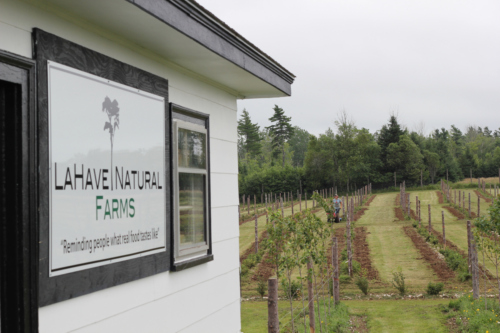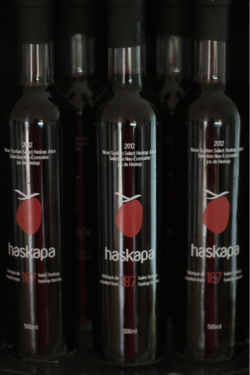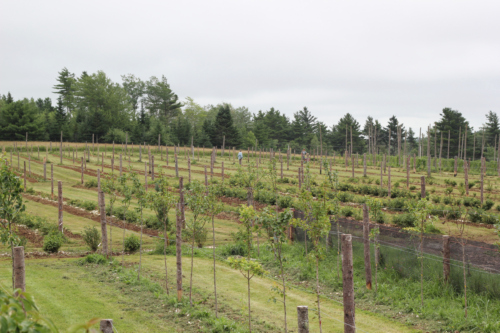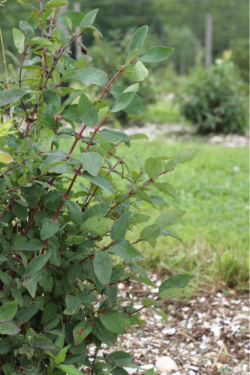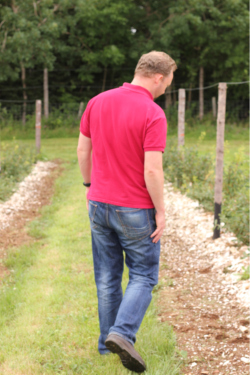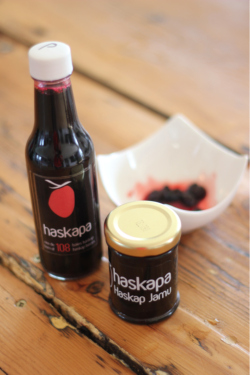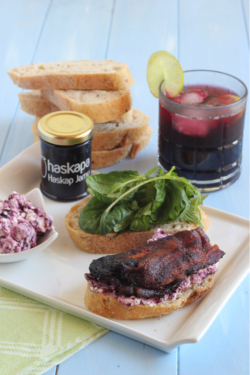Haskap Berries: Little Presents on the End of the Branch
I take a sip of cold haskap juice and finally understand. The tart, rich flavour of this little berry that originally hails from Japan and just so happens to thrive in Nova Scotia is the talk of the province. It’s packing flavour punches into everything from cocktails to granola bars to jams and salad dressings.
For those not familiar with the haskap berry, it is a small oval berry, often likened in shape to an elongated blueberry about one inch long. The skin is a dark blue, but with an intense crimson flesh. It has been described as a flavourful combination of raspberry, blackberry and blueberry. And in Nova Scotia, LaHave Forests Inc., produces the the first commercial juice of its kind in North America.
Once you’ve sipped the juice, slathered haskap jamu on a slice of fresh bread, or crunched into trail mix brightened by dried haskap berries, I guarantee you will understand the enthusiasm and hype around this berry.
It was this enthusiasm that motivated Logie Cassells and his business partner, Simon Fineman, two years ago, when they planted a haskap bush in the middle of the forest on the South Shore of Nova Scotia. They came back a year later and the bush had not only survived, but it had produced a good yield of lovely, deep magenta berries.
With such an intense flavour, purported health benefits and a double skin that might very well make a nice wine, Logie and Simon saw the potential in the haskap berry, and decided to plant a whole lot more.
Walking along the rows between seashell-nestled haskap plants (the shells, sourced locally, help to maintain a healthy mineral content for the soil, and also help reflect the sun back up to the leaves), Liam Tayler, Commercial Director for LaHave Natural Farms, where the original haskap berries were grown, tells me more about the philosophy behind the berry’s growth and success.
The motto of the Farms is to “remind people what real food tastes like.” These berries don’t need the help of chemicals with 14-letter names and three hyphens, and the products made from them don’t need added sugar. These “presents on the end of the branch,” as they’re known in Japan, are quite remarkable, all on their own.
This trust in and commitment to real and natural food extends to the nurturing of these powerful little berries as well. “We don’t grow the berries, the soil does. We are just the guardians,” Logie says of his approach to cultivating the crop.
As it turns out, the folks at LaHave Natural Farms weren’t the only ones to see the potential in this unique and exotic fruit. Since harvesting the berries that have quickly become a household name in Nova Scotia, they’ve made linkages with other individuals who are establishing haskap fields, they’re partnering with winemakers to create haskap berry wine as well as a port, and they’re working with Hell Bay Brewing Co. in Liverpool on developing a haskap beer.
The folks at Terra Beata Cranberry Farm have helped the new farmers with juicing and drying the berries, Dee Dee’s Ice Cream has created a haskap flavoured confection, and Tangled Garden has concocted a haskap liqueur. Local restaurants Mateus Bistro and The Wooden Monkey have each added haskap cocktails to their menus, and Pete’s Frootique is on board to start distributing haskap products in the very near future.
The “little berry that could” is even making it big on the international scene, finding its’ way into cocktails at Umami Burger in New York City and into Harrods department stores in the UK. On the horizon for our tiny berry friends: the haskapa brand of fresh berries, juice, jamu, dried berries and honey is set to be released and shipped on a wider scale this Fall.
Taking one last look at the tidy rows of haskap bushes sloping toward the road, I headed home to see what I could concoct with samples of haskap jam and juice that Liam had provided me.
Of course, it didn’t take me long to figure out that I wanted to introduce smoky, self-assured bacon to this outgoing little berry. My instincts were right: on to Boulangerie la Vendéenne seven grain bread went Fox Hill Cheese House Quark mixed with haskap jam, mixed greens from Noggins Corner Farm, and Pork Shop double smoked bacon caramelized in haskap juice.
For the berry that seems to have been incorporated into just about everything in its’ short time thriving in Nova Scotian soils, bacon may just be the last frontier. And, for bacon and haskap fans alike, it’s a match made in heaven.
Recipe: Haskap Bacon Sandwich with Haskap Quark and Greens

